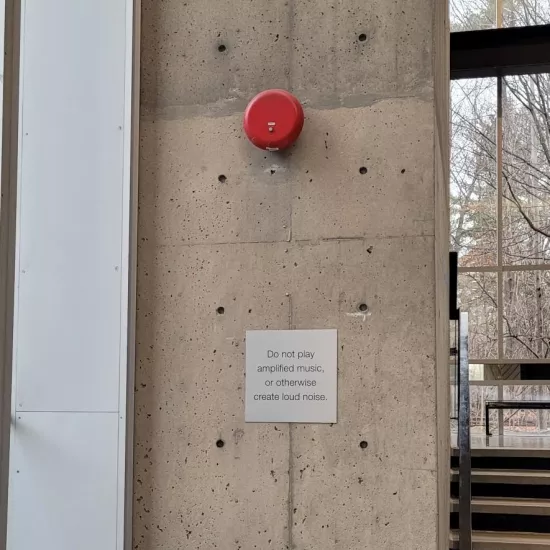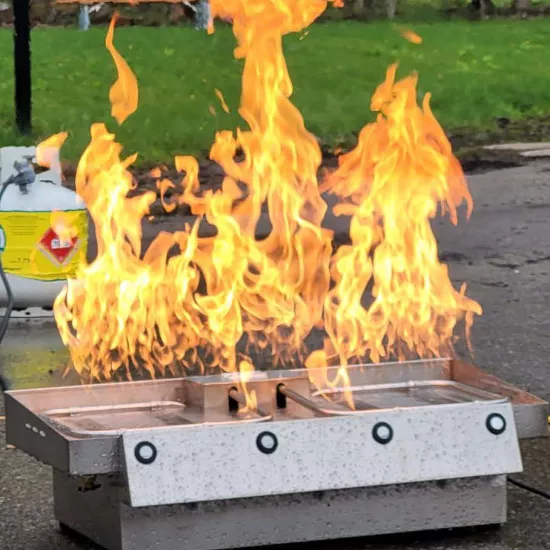If this is a fire emergency call 9-1-1 immediately.
The Fire Prevention team's mission at the University of Toronto Mississauga is to provide information about fire safety and prevention measures for the entire Campus. For questions about Fire Safety and training contact Brandon Coughlin, Fire Prevention Officer.
Quick links
In the event of a fire emergency please remain calm and remember the following:
Emergency Evacuation Procedure
IF Alarm Bells Ring
ALWAYS treat ringing fire alarm bells as a real fire and evacuate immediately.
- Stay calm; Campus buildings are designed to mitigate the spread of smoke and fire.
- Evacuate: close the door and go to the nearest marked exit.
- Help others after confirming they need assistance.
- Do not use elevators, follow the green or red EXIT signs.
- Once outside, move 25 meters away from building entrances
Keep clear of roads, fire hydrants, and emergency personnel.
IF You Discover a Fire: STAY CALM
- Trained? Use a nearby fire extinguisher if the fire has not spread.
- Untrained or unsafe? Evacuate by following the green or red EXIT signs.
- Activate a nearby Pull Station before exiting.
- Once outside, call 9-1-1.
Delegate another individual to call Campus Safety at 905-569-4333.
IF You Become Trapped: STAY CALM
- Close all nearby doors to mitigate smoke and fire spread.
- Call 9-1-1, providing your location within the building (level & room number).
- Block any gap at the bottom of the door using available materials like towels, cloth, tape, or clothing to prevent smoke from entering.
- Stay low to avoid inhaling smoke. Smoke rises pushing clean air downwards.
- Signal firefighters if possible via windows.
Fire Safety Systems
All Campus buildings have a fire alarm system that includes Fire Strobe lights, Fire Alarms and Fire Pull Stations.
Fire Strobe Lights
Fire Strobe Lights provide flashing lights in an emergency.

Fire Strobe Light on the wall of the Instructional Building.

Fire Alarm Bells
Fire Alarm Bells produce an audible alarm bell in an emergency.

A Fire Alarm Bell hanging on the wall inside the CCT Building.

Fire Pull Stations
Fire Pull Stations at Exit Doors manually activate alarms

A fire Pull Station at an exit door (in blue circle)

Exit Signs and Stairwells
Green and Red Exit signs with arrows show directions. No arrows mean to travel straight ahead.
Green Exit Sign with Graphic

Green Exit Sign and Exterior Door

Red Exit Sign (text-only)

Red Exit Sign on wall

Elevators are not usable during a fire alarm
Interior Building Exit Stairwell

Building Door to Exterior

Areas of Refuge
Where an exit is not possible, there are locations and practices within each building to protect you from smoke and fire.
Exit Stairwell

Position yourself as indicated in the image above and notify responders.
Want to find out more? Below is the annual schedule of fire alarm systems testing, as well as more tips about staying safe and available fire safety training.
The existing Fire Alarm systems located in UTM's campus buildings are tested annually in compliance with provincial regulations (O. Reg. 213/07 Ontario Fire Code)
These annual tests are independent of other Fire Alarm systems tests which take place throughout the year. 2025 annual TBD.
Fire Prevention strategies are implemented throughout the UTM campus to keep all users as safe as possible. With the Utilities team, we work to ensure fire safety systems are maintained and functioning properly.

Fire Prevention Services:
- See something of concern? Compliance Inspections can be performed from user requests
- Developing Fire Safety guidelines for processes or events
- Fire Code compliance use and hazard inspection
- Fire Alarm system maintenance with Utilities.
Do you have a request for our team? Contact UTM's Fire Prevention Officer Brandon Coughlin, 365-228-4936.
On-campus living has many similar methods to maximize individual safety, whether in a Residence Building or in a Residence Townhouse. Please review the following page for tips on staying safe.
Fire Safety Training Services:
Fire safety is a large part of any active community. At UTM, we strive to provide adequate training so we can foster a safer community both on and off campus. Safety training will differ depending on the session offered. There may be a broad focus or a specific training goal.
Training Sessions offered:

Fire Extinguisher Training (All Community Members of UofT)
- Outcome: This training is intended to familiarize individuals with the types, sizes, and operation of fire extinguishers.
- Suitable for: The training is intended for all audiences but can be specialized if you work in a hazardous environment.
- Training will be held upon request by an individual or group of individuals.

General Fire Safety Training (All Community Members of UofT)
- Outcome: This training will encompass fire safety that is applicable to various aspects of life. The sessions are intended to bring the most current fire safety information to light. Topics can be requested by the attendees but in general: cooking, smoking, electrical, and smoke/carbon monoxide alarms will be the main topics of discussion.
- Frequency: Training will be held upon request by an individual or group of individuals.

Fire drills and emergency preparedness (Supervisory Staff)
- Outcome: Fire drills are conducted on an annual basis (excluding residence) to ensure that supervisory staff are familiar with evacuation procedures. General occupants may or may not be forewarned as the intent is to simulate a real emergency.
- Suitable for: Campus Safety, Utilities, Fire Prevention, & Fire Wardens where designated as supervisory staff.
- Frequency (excluding Residence): annually
Fire Warden Training (Staff, Faculty, & Residence Dons)
- Suitable for: Fire Warden training is mandatory for those who have volunteered their time as a Fire Warden. Fire Wardens are trained in evacuation procedures, communication, fire prevention, etc.
- Frequency: Training is held on an annual basis per unit of Fire Wardens. More than one unit may be trained at once depending on unit size.
- Join our team! Click on the jacket image at left.


